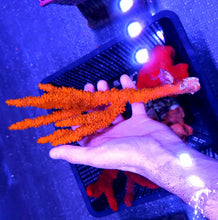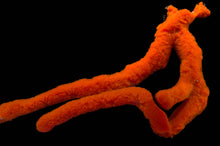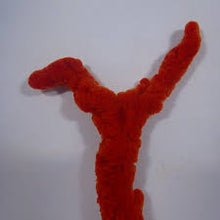🌿🔥 Finger Sponge – Red/Orange (Ptilocaulis sp.)
Quick Stats
-
Care Level: Moderate
-
Temperament: Peaceful
-
Colour Form: Bright Red or Deep Orange
-
Water Conditions: 22–26°C, dKH 8–12, pH 8.1–8.4, sg 1.023–1.025
-
Family: Axinellidae
-
Lighting: Low to Moderate
-
Supplements: Iodine, Silicates, Trace Elements
-
Water Flow: Moderate to High
-
Placement: Shaded areas, low to mid-level
Overview
The Red or Orange Finger Sponge (Ptilocaulis sp.) is a striking non-photosynthetic invertebrate, prized for its vibrant colour and elegant, finger-like branches. It adds a unique and naturalistic texture to reef aquascapes, especially when placed among live rock or tucked into shaded crevices.
This sponge naturally inhabits reef overhangs and shaded zones in the wild, often growing in nutrient-rich environments where flow delivers a steady supply of suspended food particles. Due to its distinct shape and brilliant colouration, it offers an eye-catching contrast to typical corals and soft inverts.
Note: Colours may vary under aquarium lighting. Specimens are shipped as per the photo example.
Care & Feeding
As a non-photosynthetic filter feeder, Ptilocaulis requires regular feedings of planktonic foods such as:
-
Marine snow
-
Phytoplankton and bacterioplankton
-
Dissolved organic matter and microplankton mixes
High, laminar flow is essential to keep its surface clean and deliver food efficiently. Avoid exposing the sponge to air at any time, as air bubbles trapped in its tissues can cause necrosis or death.
Optimal Parameters
-
Alkalinity (dKH): 8–12
-
Calcium (Ca): 400–450 ppm
-
Magnesium (Mg): 1250–1350 ppm
-
Nitrate (NO3): 2–15 ppm
-
Phosphate (PO4): 0.01–0.05 ppm
Placement
Position in shaded or indirect light zones of the tank, with strong but not turbulent water movement. Ideal placement is beneath overhangs or in caves. Make sure it receives consistent flow and never allow air exposure during handling or aquascaping.
🧡 Natural Reef Texture with Vivid Colour – The Finger Sponge is a living piece of reef art, perfect for mature tanks with strong filtration and dedicated feeding. Best kept by aquarists with some experience in NPS (non-photosynthetic) invertebrate care.






